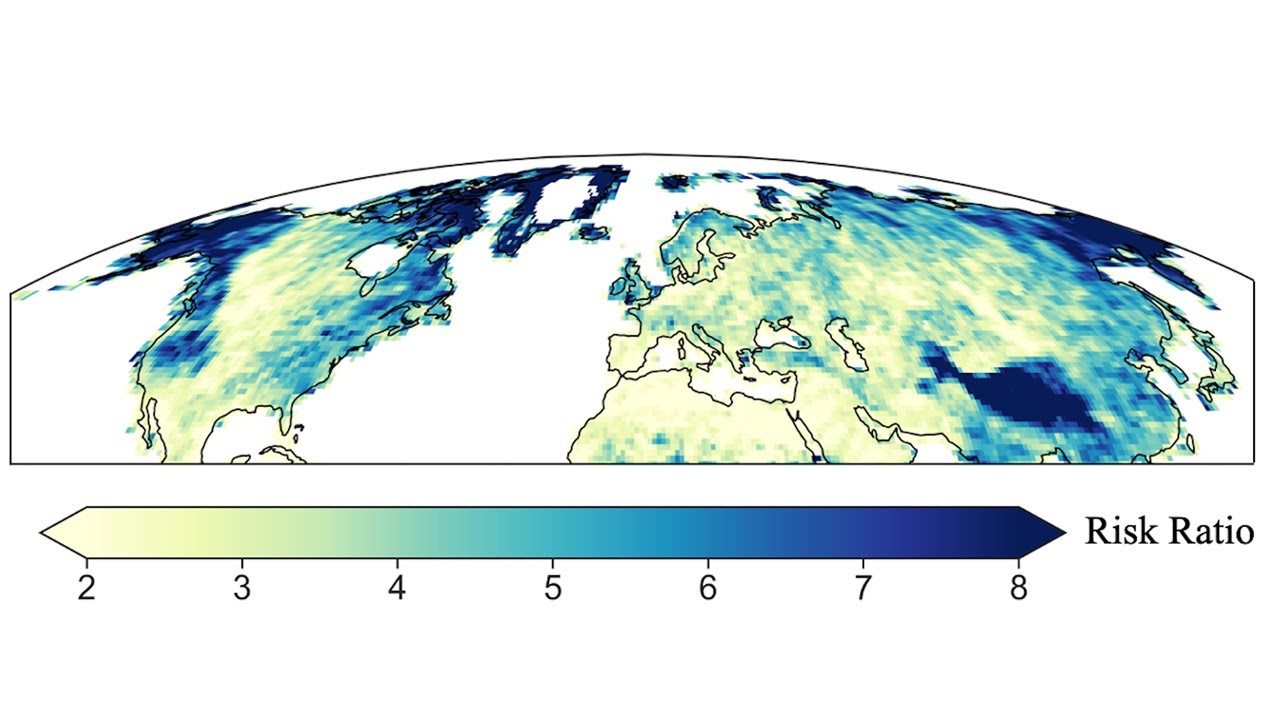My research focuses on understanding and quantifying climate change impacts on hydroclimatic extremes. From heavy storms and floods to extreme heatwaves and droughts, I study the changing characteristics of these events and their impacts on our daily lives. I use a wide range of data-driven methods such as causal inference, information theory, nonlinear dynamics and machine learning in the analysis of environmental systems. I am primarily interested in using causal inference to obtain new mechanistic insights on the impact of global warming on extreme weather events. My recent work has explored global warming impact on extreme events such as rainfall extremes, using a combination of observations and model simulations. Additionally, recent work has focused on developing new techniques to measure resilience of environmental systems to extreme events, with the ultimate goal of informing mitigation and adaptation strategies to climate change.
Map of the Northern Hemisphere showing the projected increase in extreme daily rainfall by 2100 relative to 1950–1979 (the risk ratio). Darker areas are predicted to be more prone to increased rainfall extremes with global warming.
What are some of your most interesting projects?
Resilience of Watersheds to Extreme Weather and Climate Events:
Hydrologic watersheds are the fundamental units of the land surface used in the analysis and management of water resources systems. The response of watersheds to extreme events is highly complex and determined by a multitude of factors, including the presence of dams and reservoirs, snowpack, groundwater-surface water interaction, and vegetation cover, among others. One significant knowledge gap in this field of research is how to objectively and unambiguously quantify the resilience and resistance of watersheds to extreme events, such as droughts and floods. Developing metrics to quantify resilience is of utmost importance, particularly in light of the changing characteristics of extreme events due to global warming.
In this project, I employ a wide range of statistical methods to quantify resilience. I then apply methods of machine learning, causal inference, and graph-based techniques to explore patterns of resilience across watersheds worldwide.
How did you end up where you are today?
I originally hail from Sudan, nestled at the heart of Africa. Growing up along the banks of the Nile River, I developed an early fascination with water and its profound connection to humanity. On one hand, it provides people with their needs for drinking, agriculture, transportation, and recreation. On the other hand, an excess or shortage of water often results in devastating natural disasters, such as floods, droughts, and famines. Throughout antiquity, humans have endeavored to regulate rivers by building dams, canals, and various other structures. This deep-seated interest in water sciences and related engineering disciplines led me to pursue a degree in Civil Engineering.
Following my college graduation, I chose to embark on graduate studies to delve deeper into the intricate relationship between climate change and the water cycle. Embarking on an arduous 18-hour flight, I traversed the vast Atlantic Ocean and the continental expanse of the United States to arrive in California, the Golden State. There, I successfully completed my MSc and PhD degrees at the University of California, Irvine, in just under five years. Subsequently, I relocated northward to Berkeley, where I conducted my postdoctoral research, focusing on the impact of global warming on climate extreme events. I come to University of Michigan with a deep research interest in exploring the impact of global warming on extreme events and the resilience of ecosystems to such events. My research group harness recent advances in data science (machine learning, causal inference and information theory) to obtain new mechanistic and predictive insights on these questions with the ultimate goal of informing climate change adaptation strategies.
